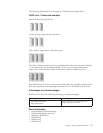
The spare drive is actually part of the RAID level-5E array, as shown in the
following example. With such a configuration, you cannot share the spare drive
with other arrays. If you want a spare drive for any other array, you must have
another spare drive for those arrays.
RAID level-5E requires a minimum of four drives and, depending upon the level
of firmware and the stripe-unit size, supports a maximum of 8 or 16 drives. RAID
level-5E is also firmware-specific.
Note: For RAID level-5E, you can have only one logical drive in an array. When
using RAID level-5E, you can have a maximum of seven logical drives on
the controller.
The following illustration is an example of a RAID level-5E logical drive.
RAID level-5 Enhanced example
Start with four physical drives.
Create an array using all four physical drives.
Then create a logical drive (labeled as 1) within the array. Notice that the
distributed spare drive is the free space (labeled as 2) shown below the logical
drive.
The data is striped across the drives, creating blocks in the logical drive. The
storage of the data parity (denoted by * ) is striped, and it shifts from drive to
drive as it does in RAID level-5. Notice that the spare drive is not striped.
If a physical drive fails in the array, the data from the failed drive is reconstructed.
The array undergoes compression, and the distributed spare drive becomes part of
the array. The logical drive remains RAID level-5E.
When you replace the failed drive, the data for the logical drive decompresses and
returns to the original striping scheme.
40 ServeRAID Manager Installation and User's Guide


















